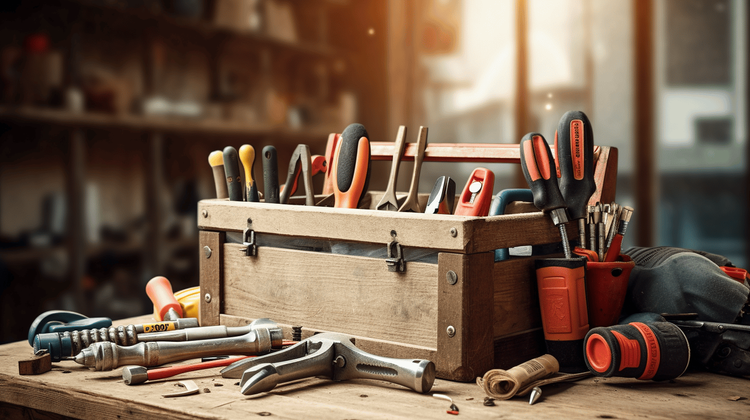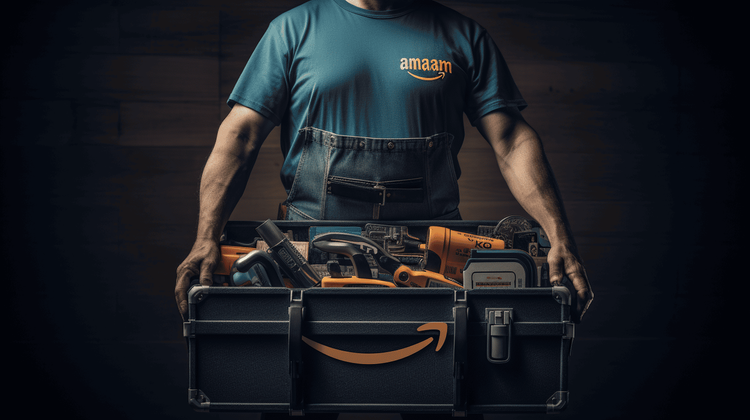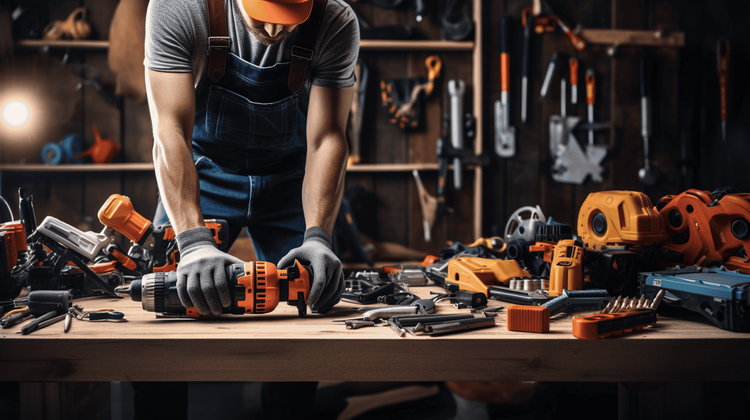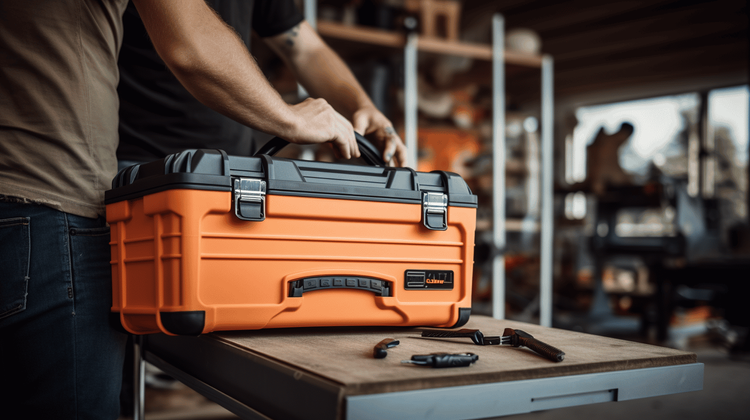The Thrifty DIYer's Handbook: Navigating Affordable Tool Options
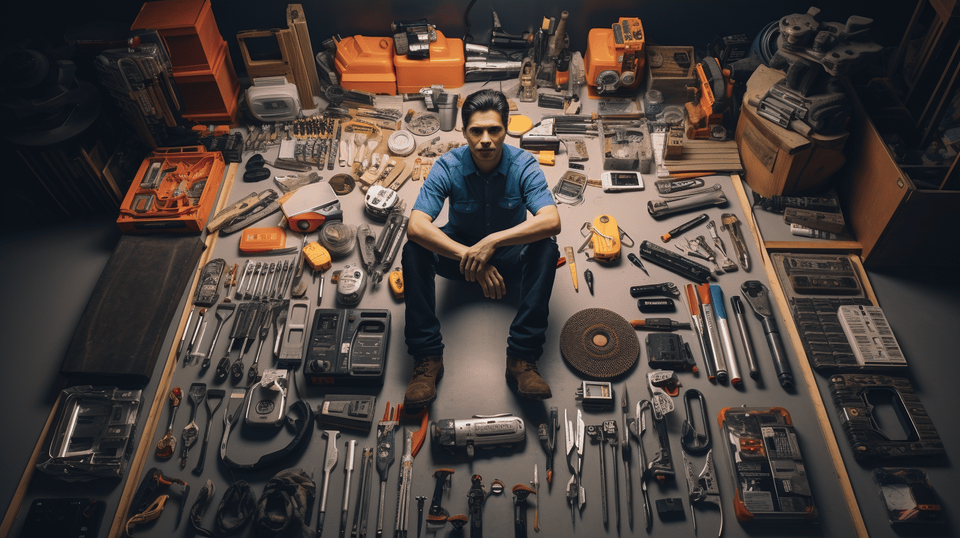
Imagine the thrill you feel when you venture into the world of Do-It-Yourself (DIY) projects. This journey, a blend of creativity, problem-solving, and hands-on work, is incredibly enriching. However, if you're a thrifty DIYer, you face one particular challenge — finding the right tools at the right price. 🛠️💰
You see, tools are the backbone of each DIY project, regardless of its scale. They allow you to bring your artistic visions to life and solve practical problems around your home. But they can also be quite expensive, transforming your hobby or passion into a drain on your wallet. This is where this guide comes in: 'The Thrifty DIYer's Handbook: Navigating Affordable Tool Options.'
In this comprehensive guide, we will explore the landscape of great value tools. You'll understand the significance of tools in DIY projects, learn how to select high-quality, budget-friendly options, and discover where to find hidden gems. We'll also delve into the different types of tools and their affordable alternatives, learn some handy tips and tricks for maintaining your tools, and cover safety precautions you need to follow.
So, strap on your tool belt, and let's embark on this journey together — a pathway to accomplishing marvelous DIY projects without breaking the bank! 💪🎨💡
Understanding DIY and the Importance of Tools
What is DIY?
When it comes to crafting, knack for innovation, or revamping your living space, one term tends to take the spotlight: DIY or "Do-It-Yourself". DIY, in its essence, is a potent principle of self-reliance, allowing you to create, repair, or modify something without the direct aid of professionals or experts. It's all about putting on your creativity hat, donning your safety gloves, and making something astounding that's a product of your imagination, effort, and skill. And it's not just about saving dollars (though that's a big part!), but also about learning, enjoying the process, and achieving a sense of accomplishment.
Encompassing a wide array of activities, DIY can range from knitting a sweater for your furry friend, to building a beautiful back-yard treehouse for your kids, painting a canvas, making jewelry, or fixing a leaking pipe at home. 👩🔧👨🎨🧶
While DIY may seem an intimidating endeavor to the uninitiated, in truth, anyone can jump on the DIY bandwagon. All one needs are some vital tools, the right attitude, a dollop of patience, and a generous helping of enthusiasm!
Essential Tools for DIY Projects
Armed with the knowledge and passion for DIY, what you need next is a set of essential tools. This toolkit would, believe it or not, transform your DIY dreams into reality.
- Hammer and Nails: Feeding into the saying, 'every problem looks like a nail when you only have a hammer', having these handy ensures you're ready for most basic DIY tasks. 🛠️
- Tape Measure: Remember the old carpenter's saying - "Measure twice, cut once." A tape measure is the first step to precision.
- Utility Knife: For slicing through cardboard, wires, carpet, you name it - a utility knife is a multifunctional gem for your toolkit.
- Screwdriver Set: Unscrewing lids, assembling furniture, installing fixtures – a diverse screwdriver set can prove to be your knight in shining armor!
- Drill: A bit more advanced perhaps but incredibly versatile. From mounting a TV to creating stunning wall art, a DIY enthusiast's world revolves around this tool.
- Pliers: When things get a tad too tight or out of hand, a pair of pliers lends that lacking strength.
- Level: For those who love order and symmetry, a level ensures your DIY projects measure up to perfection.
A fully equipped toolbox can elevate your DIY game to impressive heights. But remember, it's not the tools in the box; it's the person using them! Happy DIY-ing, folks! 🎉💪🏠
"You only fail if you stop trying." – What an enthusiastic DYI-er would quote!
Navigating Affordable Tool Options
The sea of tools on the market can appear like an overwhelming maze to the unseasoned DIY-er — a myriad of brands, features, and, most importantly: prices. You'd think that accumulating a well-stocked toolbox would have you diving into your life savings. But fear not: affordable tool options are surprisingly plentiful. You just need to know where to look and what to look for. In this article, we hope to unravel the mystery of finding affordable tools without sacrificing quality or functionality. So, let’s dive in.👀
Criteria for Choosing Affordable Tools
When it comes to filling your toolbox (without emptying your pockets), several factors should play into your selection. There are three main criteria that are crucial in making your decision:
- Quality: Just because you're looking for affordability, it doesn’t mean you should settle for shoddy craftsmanship. Ensure that the tool is durable and long-lasting.
- Relevance: Don’t fall into the trap of buying tools you’ll rarely use, no matter how good the deal. Stick to the basics until the need arises for something more specialized.
- Versatility: Aim to find tools that can perform multiple functions. Multifunction tools can be a game-changer when on a budget, feature an all-encompassing solution, and save your toolbox space.
It might take some extra time to hunt down the perfect mixture of these three elements, but your wallet will thank you in the long run.
"Give me six hours to chop down a tree, and I will spend the first four sharpening the axe." — This quote from Abraham Lincoln reminds us of the importance of choosing the right, quality tools.
Where to Buy Affordable Tools
No list about affordable tool options would be complete without mentioning the places you can score such deals:
- Online Marketplaces: Websites like Amazon and eBay are treasure troves of new and used tools at different price points. User reviews provide a reliable source of information about the product's quality too.
- Brick and Mortar Stores: Your local hardware store often holds sales and giveaways where you could nab some budget-friendly tools. Be on the lookout for flyers and in-store signage.
- Garage Sales/Thrift Stores: These can be a goldmine for affordable tools. Just remember to check the tool condition before making a purchase.
- Tool Libraries: Organizations often offer tools for rent for a small fee or free. This could be a valuable option for one-time use tools.
Hidden Gems for Affordable Tools
Beyond conventional purchasing methods, there are many alternative ways to acquire tools on a budget. Here are three underrated options:
- Bartering or exchanges: Trade an unused tool with a friend or join a tool exchange group.
- Tool insurance claims: Damaged tools covered under insurance can sometimes be replaced at a lower cost.
- Promotional offers: Some suppliers offer free tools alongside the purchase of big-ticket items.
The bottom line: With some research and a touch of creativity, obtaining affordable tools can be made as easy as hammering a nail into wood. Happy tool hunting! 🛠️
Types of Tools and Their Budget-Friendly Options
With the sheer variety of tools in the market, handpicking what you need can be an uphill task, especially when working on a tight budget. But hey, DIY enthusiasts, fret not! This handy guide will walk you through different types of tools and their budget-friendly alternatives. Let's get started!
Hand Tools
Hand tools, as the name implies, are tools wielded manually without any motor or electric power source. They include traditional tools like:
- Hammers: Essential for any project, hammers come in various shapes and sizes. A good quality claw hammer for basic home use won't set you back more than $10-$15.
- Screwdrivers: Most screwdriver sets come with different types, sizes, and shapes, making them versatile. A functional, budget-friendly set can be purchased for under $20.
Hand tools, due to their simplicity, are usually cheaper compared to their powered counterparts. They're perfect for those looking for a cost-effective way to handle minor repairs and projects around the house.
Power Tools
Contrary to hand tools, power tools utilize an external power source, typically electricity or batteries. These tools make labor-intensive tasks smoother and quicker. The bang for your buck power tools include:
- Cordless Drills: These power tools are a must-have for any DIYer, providing unmatched convenience. Cordless drills run anywhere from $50 to several hundred, but budget-friendly options exist under $100.
- Circular Saws: Known for their versatility, you can pick up a budget circular saw for $100 or less.
While power tools can be pricier, investing in a few key pieces can prove economical in the long run as they considerably reduce manual labor and time.
Specialized Tools
Lastly, we have specialized tools designed for specific tasks. Some examples are:
- Wood Routers: These are used for hollowing out wood or cutting fancy edges. Though not as commonly used as the other tools, a budget-friendly wood router won't cost you more than $100.
- Air Compressors: Used for a variety of tasks, from inflating tires to powering pneumatic tools, air compressors can be found at a reasonable price below $150.
The proverb "You get what you pay for" rings true when it comes to tools. Even if you're on a shoestring budget, don't underestimate the importance of quality. Remember: A well-maintained, high-quality tool can outlive multiple cheaper ones, making it a wiser investment in the long run. So, choose wisely, and happy DIY-ing! 🛠️
Maintaining Your Tools: Tips and Tricks
Who says only humans require proper grooming and healthcare? It seems that our trusty tools also need a little TLC to keep functioning at their absolute best. After all, they're the unsung heroes of our DIY projects, home repairs, and creative art works. But don't fret! We have put together some easy-to-implement tips and tricks to help you maintain your tools, letting them serve you well for years to come.
Cleaning
Let's begin with the basics, shall we? Cleaning your tool after use can make a significant difference in how it performs and its overall lifespan. Also, who doesn’t love a shiny and pristine tool kit, right?
- Remove debris: Wipe off any dirt, dust, or debris from your tools. You don't want them to become a breeding ground for rust.
- Use appropriate cleaning solutions: Depending on the material of your tools, use relevant cleaning solutions. For instance, a mild dish soap works wonders for metal tools.
- Dry them thoroughly: Always remember to dry your tools before storing them. Excess moisture can cause rust to form on metal tools.
Proper Storage
Moving on to storage. Where and how you store your tools matter as much as how you clean them. Storing your tools properly can protect them from various elements such as dust, moisture, and even accidental damages. Here's how you can do it:
- Use a toolbox or tool drawer: Store your tools in a dedicated toolbox or drawer.
- Silica gel packets: Use silica gel packets in your toolbox or drawer to absorb excess moisture.
- Organize: Based on the frequency of use, organize your tools. This not only helps in easy retrieval but also prevents unwanted scratches caused by tool clashes.
Regular Tool Maintenance
Just cleaning and storing won’t cut it if you're looking for longevity. Regular maintenance comes into play, ensuring your tools are always in prime condition.
- Regular oxidation check: Check for signs of rust or oxidation on your metal tools. If spotted, it's time for a good scrubbing!
- Lube those joints: Regularly lubricate the moving parts of your tools to prevent stubborn rust and unwanted stiffness.
- Regular sharpening: To maintain cutting tools, ensure regular sharpening so they can give you a clean cut every time.
Remember, your tools are as good as how you treat them. You give them love, and they'll shower it back. "In a world full of things, sometimes it's the tool that makes you," a wise man once said. So, let's respect our tools, treat them right, and they will be our best friends for all our DIY ventures. Keep them clean, store them right and don’t forget those regular health checks! 😊
Safety Precautions When Handling Tools
Without a doubt, everyone loves a well-done DIY project. However, did you ever stop to ponder how you're handling those tools you adore? Could you possibly be putting yourself at unnecessary risk? 😨
Today, we're here to cover an essential and often overlooked topic - safety precautions when handling tools. Whether you're a seasoned DIY enthusiast or a beginner, these comprehensive guidelines should never be taken for granted. Let’s dive in! 🏊♂️
Understanding Safety Instructions
First and foremost, acquaint yourself with each tool's safety instructions. You know, those little booklets that come with every new tool? They're not merely for decoration - they pack significant insights 📖. While they might seem daunting due to the technical jargon, understanding these instructions can and will save fingers. After all, accidents can happen even with the simplest of tools!
Here are a few quick tips to help you decipher those safety manuals:
- Familiarize yourself with the parts and functions: Knowing your tool and its parts is like knowing the back of your hand. Learning this simple knowledge reduces the chances of mishaps significantly.
- Understand the safety symbols: These symbols convey valuable information and warnings about potential hazards.
- Pay attention to explicit warnings and cautions: Manufacturers usually emphasize these for a good reason. They're not just add-ons!
Proper Usage of Different Tools
Every tool in your toolbox has a specific use — using a flat-head screwdriver as a chisel? Bad idea! 👎 Remember, misusing tools not only leads to poor results but could potentially cause serious harm.
Here are the best practices for common tools:
- Power Drills: Always hold the drill with both hands when in operation. This will offer full control and minimize complications from accidental slips.
- Hammers: Ensure to use the appropriate type of hammer for the task and avoid striking nails and other objects with the side of the hammer.
- Screwdrivers: Use the correct type and size of screwdriver for each screw – this eliminates slipping and leaves your fingers injury-free.
Importance of Personal Protective Equipment (PPE)
Last but not least, remember to equip yourself with the right PPE whenever you're in the workshop. Slipping on a robust pair of gloves or safety glasses might seem superfluous to some, but trust us, you do not want to experience an eye injury because of a neglected pair of safety glasses. 🥽
From protective footwear, gloves, to respirators and dust masks, ensure you're wearing the right protective gear for the task at hand. Safety is non-negotiable!
Knocking together that new bookcase or fixing up the squeaky stair should not come at the cost of your well-being. Remember these safety precautions while handling tools and you'll be better equipped to navigate your DIY projects confidently and safely! So now that you're versed on safety, why not pick up that hammer and give it a go? Building dream projects has never been so safe! 🛠️
Maximizing Effectiveness of Tools While Staying Within Budget
In today's do-it-yourself culture, having the right tools for the job certainly makes all the difference. Striking a balance, however, between having quality tools and staying within a budget can sometimes feel like an uphill battle. This invigorating tug-of-war will always have a happy ending if you follow some insightful strategies. So let's delve right in!
Renting vs Buying Tools
First things first, you have to understand when renting tools would be more beneficial than buying them. For instance, if you're embarking on a one-time project, it may be more cost-effective to consider renting the required equipment. On the flip side, if the tools are ones you'll use often in your work or everyday life, it might be a wise investment to purchase them. To make the best decision, assess your current and future project needs, evaluate the renting or buying costs, and ruminate over these points:
- How often will you use the tool?
- What's the cost of renting versus buying?
- Do you have adequate space for storage?
Reutilizing and Multifunctional Tools
In the realm of budget-friendly tool procurement, reutilizing tools and investing in multi-purpose ones is a game-changer.
Tools that serve multiple purposes can dramatically cut costs and save storage space— think of them as the swiss army knives in your toolbox. A cordless drill, for instance, can serve as a power screwdriver when you're in a squeeze.
On the other hand now, creatively reutilizing your existing tools for new tasks can stretch their value even further. It's all about being ingenious and finding new ways to use what you already have.
Investing in Quality, Affordable Tools
Lastly, we can't overlook the significance of investing in quality tools that offer value for money. They might be a bit more expensive initially, but in the long run, their durability, effectiveness, and ability to withstand the test of time prove to be cost-effective. But remember, quality doesn't always mean expensive. There are a plethora of affordable tools that perform remarkably well. Here's a quick rundown of attributes to look out for:
- Tools from reputable manufacturers
- Positive user reviews
- Robust and durable design
- Warranty periods
At the end of the day, you get to determine what "effective tool use" means to you and your personal needs. It could mean renting, repurposing, or opting for multi-purpose tools. Or it could mean a strategic investment in quality, affordable tools. The decision is yours - just remember to stay within your budget!
🛠️
Conclusion
From DIY aficionados to professional tradespeople, having a reliable and affordable set of tools is integral to success. Understanding the purpose of your tools, keeping them in good condition, and using them safely can drastically increase their lifespan, improving your investment.
There are budget-friendly options on the market for every conceivable DIY task, from hand tools to power tools, and even specialized equipment. We've uncovered hidden gems in unexpected places and discussed the benefits of buying versus renting, as well as the potential for multi-purpose tools.
Sometimes, however, it's the smaller accessories like the Bit Holder Keychain for screwdriver bits from Ultra Handy that can make a world of difference. This nifty gadget keeps your bits organized and easily accessible while working, saving you time and reducing frustration.
Remember, investing in good-quality, affordable tools, and treating them with care, will not only save you money in the long term but also support a safe and efficient working environment. Stay thrifty, stay handy, and most importantly, stay safe! For more tips and tricks, check us out at Ultra Handy.
Frequently Asked Questions
- What are some affordable tool options for thrifty DIYers?Some affordable tool options for thrifty DIYers include: 1. Second-hand tools from yard sales or online marketplaces, 2. Renting tools from local hardware stores, 3. Borrowing tools from friends or family, 4. Shopping for discounted tools at clearance sales or outlet stores, 5. Looking for budget-friendly tool brands or generic options.
- Are cheaper tools of lower quality?Not all cheaper tools are of lower quality. Some affordable tool brands offer decent quality for the price. However, it's important to read reviews, check warranties, and research the brand reputation to ensure you're getting a reliable tool that meets your needs.
- What are the advantages of buying used tools?Buying used tools can save you money and allow you to acquire higher-quality tools within your budget. Additionally, used tools from reputable sellers can still be in good condition and have plenty of life left in them.
- Should I prioritize buying power tools or hand tools?The priority between power tools and hand tools depends on the type of projects you undertake. Power tools, such as drills or saws, are handy for complex or heavy-duty tasks, while hand tools, like screwdrivers or wrenches, are useful for finer, more delicate work. Assess your needs and budget accordingly.
- Are there any tool rental services available for thrifty DIYers?Yes, many local hardware stores offer tool rental services. This option allows you to access expensive or specialized tools for a fraction of the cost, making it ideal for one-time projects or when you don't want to invest in purchasing a particular tool.
